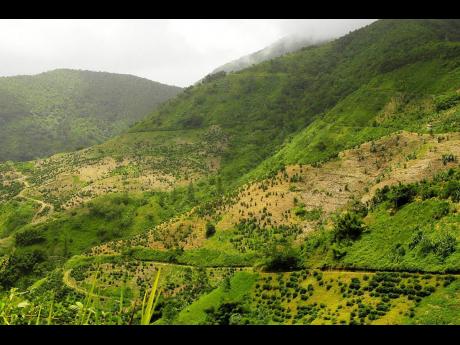Coffee and water don’t always mix
Sector bleeds $500m as rain clobbers crops
Recent rains have led to nearly $500 million in lost coffee crops. Farmers lost up to 30 per cent of their beans, which were often too fat to hang on to the tree limbs after getting soaked by continuous downpours. “You couldn’t get pickers to go...
Recent rains have led to nearly $500 million in lost coffee crops.
Farmers lost up to 30 per cent of their beans, which were often too fat to hang on to the tree limbs after getting soaked by continuous downpours.
“You couldn’t get pickers to go out and pick in the rain, and when the beans are on the ground, it has already started to decay,” said Lundine Anderson of Trouble Hill farm, who owns and operates a 100-acre property, half of which grows coffee.
It always rains in the Blue Mountains, where the micro climate is seen as ideal for coffee cultivation. This time, however, the downpour has not abated since last November.
The rains cut Anderson’s crop by 500 boxes, down from his 2,500-production capacity.
The third-generation coffee farmer bought property six years ago to transition from being a subsistence farmer to owning a large farm. The name Trouble Hill was inherited from the previous owner in Claverty Cottage in Portland.
He will be seeking licences to start processing his own coffee, as he reorients his business towards become a ‘from bean to cup’ operation.
Coffee regulator the Jamaica Agricultural Commodities Regulatory Authority, which is better known by its acronym JACRA, initially projected output of 300,000 boxes for the 2023-24 coffee crop, up from 240,000 boxes a year earlier. But due to rain damage, that target appears unlikely to be met. The crop year ends in a few months, but the regulator still hasn’t received two-thirds of the expected volumes, industry sources said.
“It is estimated that losses incurred by the industry at the farm gate amounted to a minimum of 50,000 boxes at a farm gate value of $480 million of crop loss,” said Norman Grant, chairman of the Jamaica Coffee Exporters Association and head of Mavis Bank Coffee Factory, one of Jamaica’s oldest coffee operations..
This has been compounded by the loss of trees, resulting in the future loss of cherry berries. Additionally, production costs are rising, Grant noted.
Jamaican coffee fetches US$50 a pound on world markets or about five times more than the typical coffees from respected producer markets like Colombia and Kenya. Jamaica’s coffee has achieved luxury-brand status in a world dominated by bargain commodities. But it is not easy to keep that standard, and production keeps falling due to myriad factors, with rain now being the latest. Other factors include farmer fatigue, theft, and crop disease.
“The rains were okay but the borer disease”, hit the crops hard, lamented Roderick ‘Blacks’ Ferguson, who grows coffee in Middleton, which lies beyond Irish Town in the hills of St Andrew. He said he lost about 30 per cent of his crop.
Coffee is grown across Jamaica by about 5,000 farmers, most of whom operate plots of less than five acres.
Most small farmers cannot produce more than 50 boxes per acre, and when challenges occur, they become cash-strapped. Currently, farmers are paid $8,000 per box when they sell a standard wooden box filled with coffee to large factories.
Anderson, who grew up around coffee, decided early on that he would not do coffee as a “lifestyle, but as a business”. Approaching it as a business, he said, allows farmers to weather the highs and lows in the prices offered for beans from crop year to crop year.
Anderson expects prices for farmers to eventually return to highs of a decade ago, that is, $15,000 per box.
“At some point, it will go to record levels,” he said, basing his reasoning on sustained demand at a time when production is falling, thereby lowering supplies.
“Every year, about 50 farmers leave the sector. In the past, we produced 750,000 boxes, and now can barely make 200,000 boxes. It is not encouraging for small farmers,” he said.
On his lands, Anderson produces cash crops, including coconut, yam, banana, and dasheen. He also plans to diversify into the development of cottages for short-term rental to augment income and offset losses from farm theft.
When Anderson was first contacted for this interview, he did not respond right away.
“I couldn’t respond to your questions at the time because my house was broken into,” the Trouble Hill principal said. “We just have to go on,” he said.


